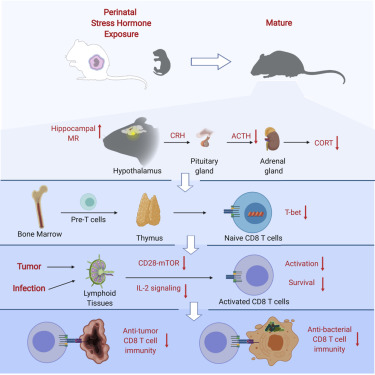|
|
Developmental Biology - Stress In Pregnancy
Stress In Pregnancy Can Last a Lifetime
Mice exposed to stress in the womb and soon after birth can expect a lifetime of immune system deficiencies...
Mice exposed to stress in the womb and soon after birth can expect a lifetime of immune system deficiencies that hinder the ability to ward off infections and cancer, Yale University researchers report March 5 in the journal Cell.
In a new study, they tracked a lifetime of physiological changes experienced by mice given a liquid solution containing the stress hormone glucocorticoid while in the womb or soon after birth.
Glucocorticoids are naturally occurring hormones that reduce inflammation and are instrumental in helping infants and adults alike adapt quickly to environmental dangers, such as famine or violence.
Physicians use them to treat asthma and autoimmune diseases caused by overactive immune systems, for example.
But, researchers found early-life exposure to the stress hormone can permanently alter many immune system responses, decreasing the body's ability to ward off bacterial infections and fight tumors.
"Mice for rest of their lives are rewired and reprogrammed in ways fundamentally different from those not exposed to glucocorticoids," explains Yale immunobiologist Ruslan Medzhitov, a senior author of the study and Howard Hughes Medical Institute investigator.
Medzhitov and first author Jun Young Hun, also of Yale, catalogued a host of physiological changes that occurred in mice given glucocorticoids and that had serious consequences for the rest of their lives.
As adults, high dose glucocorticoid exposed mice are more susceptible to bacterial infections and tumors than mice without exposure. A specific physiological change is the decreased activity of a key T cell response to pathogens or other threats.
The study helps explain why individuals vary so widely in their ability to ward off infections, the authors say. It also provides an explanation for a social phenomenon found throughout human history: an emphasis on shielding women from stress during pregnancy.
"In all cultures, there are efforts to shelter women from stress during pregnancy. The effects of early life stress don't just go away."
Ruslan Medzhitov PhD, Department of Immunobiology, Yale University School of Medicine, New Haven, CT; Howard Hughes Medical Institute, Chevy Chase, MD, USA; and senior author of the study.
As more is learned about molecular changes caused by early exposure to stress, the more likely it is that medical science will find a way to minimize its damage, say the authors. "We aren't there yet," Medzhitov adds.
Abstract Highlights
• Early-life stress has a long-term effect on the immune system
• Perinatal glucocorticoids exposure changes the set-point of the HPA axis
• Reduced GR signaling decreases CD8 T cell function by altering chromatin at key loci
• Perinatal glucocorticoids result in susceptibility to tumors and bacterial infection
Summary
Early life environmental exposure, particularly during perinatal period, can have a life-long impact on organismal development and physiology. The biological rationale for this phenomenon is to promote physiological adaptations to the anticipated environment based on early life experience. However, perinatal exposure to adverse environments can also be associated with adult-onset disorders. Multiple environmental stressors induce glucocorticoids, which prompted us to investigate their role in developmental programming. Here, we report that perinatal glucocorticoid exposure had long-term consequences and resulted in diminished CD8 T cell response in adulthood and impaired control of tumor growth and bacterial infection. We found that perinatal glucocorticoid exposure resulted in persistent alteration of the hypothalamic-pituitary-adrenal (HPA) axis. Consequently, the level of the hormone in adults was significantly reduced, resulting in decreased CD8 T cell function. Our study thus demonstrates that perinatal stress can have long-term consequences on CD8 T cell immunity by altering HPA axis activity.
Authors
Jun Young Hong, Jaechul Lim, Fernando Carvalho, Jen Young Cho, Bharat Vaidyanathan, Shuang Yu, Charles Annicelli, W.K. Eddie Ip and Ruslan Medzhitov.
Acknowledgements
The authors thank Katarzyna Kolasa for illustrations. This manuscript has been released as a pre-print (doi: 10.20944/preprints201910.0144.v4).
Conflicts of Interest
The authors declare no conflict of interest.
Funding
This study was supported by the European Regional Development Fund, the Mobilitas Pluss Project MOBTT39 (to D.K.).
Return to top of page.
| |
|
Mar 9 2020 Fetal Timeline Maternal Timeline News
 Research found early-life exposure to the stress hormone glucocorticoid can permanently alter many immune system responses, decreasing a body's ability to ward off bacterial infections and fight tumors.
CREDIT Howard Hughes Medical Institute, YALE University.
|



